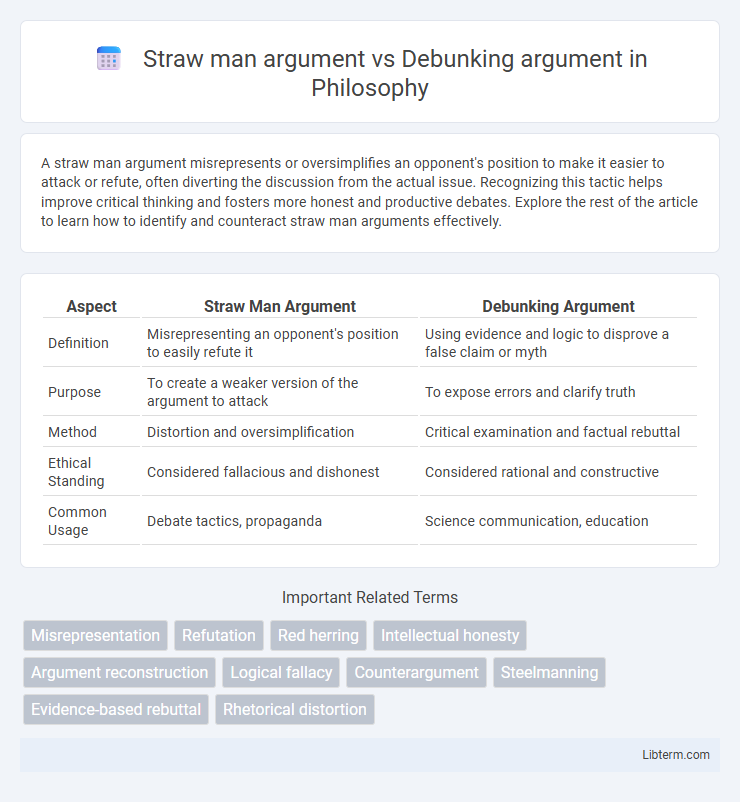A straw man argument misrepresents or oversimplifies an opponent's position to make it easier to attack or refute, often diverting the discussion from the actual issue. Recognizing this tactic helps improve critical thinking and fosters more honest and productive debates. Explore the rest of the article to learn how to identify and counteract straw man arguments effectively.
Table of Comparison
| Aspect | Straw Man Argument | Debunking Argument |
|---|---|---|
| Definition | Misrepresenting an opponent's position to easily refute it | Using evidence and logic to disprove a false claim or myth |
| Purpose | To create a weaker version of the argument to attack | To expose errors and clarify truth |
| Method | Distortion and oversimplification | Critical examination and factual rebuttal |
| Ethical Standing | Considered fallacious and dishonest | Considered rational and constructive |
| Common Usage | Debate tactics, propaganda | Science communication, education |
Introduction to Straw Man and Debunking Arguments
A straw man argument misrepresents an opponent's position to make it easier to attack, often by exaggerating or simplifying the original claim. Debunking arguments aim to expose falsehoods and correct misinformation by presenting evidence and logical reasoning. Understanding these contrasting techniques is essential for evaluating the strength and validity of debates and discussions.
Defining the Straw Man Argument
The Straw Man argument is a logical fallacy where a person misrepresents or oversimplifies an opponent's position to make it easier to attack or refute. This tactic involves creating a distorted version of the original argument rather than engaging with the actual claims presented. Recognizing the Straw Man fallacy is crucial for clear critical thinking and effective debate.
What is Debunking an Argument?
Debunking an argument involves systematically exposing false claims, logical fallacies, or misinformation within an opposing viewpoint to reveal its flaws and promote accurate understanding. Unlike a straw man argument, which misrepresents or oversimplifies an opponent's position to easily refute it, debunking aims to directly address and correct the actual statements made. Effective debunking relies on evidence-based reasoning, critical analysis, and transparent communication to dismantle incorrect assertions without distortion.
Key Differences Between Straw Man and Debunking
A straw man argument misrepresents or oversimplifies an opponent's position to make it easier to attack, often distorting the original claim. In contrast, debunking arguments focus on providing factual evidence and logical reasoning to refute false claims or misconceptions directly. Key differences include the straw man's use of intentional mischaracterization versus debunking's reliance on accurate representation and critical analysis of the argument.
Common Examples of Straw Man Arguments
Common examples of straw man arguments include misrepresenting an opponent's stance on climate change as denying all environmental concerns, oversimplifying a call for healthcare reform as wanting to eliminate all private insurance, or exaggerating a request for stricter gun control laws as seeking a complete ban on firearms. These tactics distort original claims to make them easier to attack and refute, undermining productive debate. Recognizing these misrepresentations helps in focusing discussions on the actual positions and evidence presented.
Effective Techniques for Debunking Arguments
Effective techniques for debunking arguments involve accurately representing the opponent's position to avoid the straw man fallacy, which misrepresents or oversimplifies their stance. Emphasizing fact-based evidence, logical reasoning, and clear explanations helps dismantle false claims while maintaining intellectual integrity. Utilizing credible sources and addressing the core points directly increases the persuasive power of debunking strategies.
Psychological Impact on Audiences
Straw man arguments often distort an opponent's position, triggering cognitive biases that lead audiences to misjudge the original claim, fostering polarization and resistance to genuine dialogue. Debunking arguments, when effectively structured with clear evidence and logical reasoning, can reduce misinformation by engaging critical thinking processes and promoting cognitive reflection. The psychological impact of these techniques hinges on audience openness and prior beliefs, with debunking more likely to encourage belief revision while straw man tactics reinforce entrenched viewpoints.
Why Straw Man Arguments Undermine Discourse
Straw man arguments undermine discourse by misrepresenting an opponent's position, creating a distorted version that is easier to attack rather than engaging with the actual argument. This tactic diverts attention from genuine issues, fosters misunderstanding, and erodes constructive dialogue essential for critical thinking and problem-solving. Effective debunking arguments rely on accurately addressing claims with evidence and logic, promoting clarity and intellectual honesty in discussions.
Role of Debunking in Critical Thinking
Debunking arguments play a vital role in critical thinking by exposing false claims and misconceptions, thereby promoting intellectual clarity and accuracy. Unlike straw man arguments, which distort opposing viewpoints to undermine them unfairly, debunking seeks to rigorously analyze and refute errors through evidence-based reasoning. This process strengthens analytical skills and encourages discerning evaluation of information, essential components of effective critical thinking.
Avoiding Fallacies: Best Practices for Productive Debate
Straw man argument involves misrepresenting an opponent's position to make it easier to attack, leading to unproductive debates and fallacies. Debunking argument relies on presenting accurate evidence and logical reasoning to refute false claims, fostering clarity and constructive dialogue. Avoiding fallacies requires careful listening, accurately representing opposing views, and prioritizing evidence-based responses for productive debate outcomes.
Straw man argument Infographic

 libterm.com
libterm.com